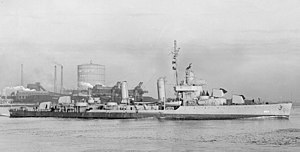
Summary
USS Bristol (DD 453) was a Gleaves-class destroyer of the United States Navy, named for Rear Admiral Mark Lambert Bristol. She was launched 25 July 1941 by Federal Shipbuilding, Kearny, New Jersey; sponsored by Mrs. Powell Clayton.The destroyer was commissioned on 22 October 1941.

| |
| History | |
|---|---|
| Name | Bristol |
| Namesake | Mark Lambert Bristol |
| Builder | Federal Shipbuilding and Drydock Company |
| Laid down | 20 December 1940 |
| Launched | 25 July 1941 |
| Commissioned | 22 October 1941 |
| Fate |
|
| General characteristics | |
| Class and type | Gleaves-class destroyer |
| Displacement |
|
| Length |
|
| Beam | 36 ft (11 m) |
| Draft |
|
| Propulsion |
|
| Speed | 37.5 kn (69.5 km/h; 43.2 mph) |
| Range | 6,000 nmi (11,000 km; 6,900 mi) at 15 kn (28 km/h; 17 mph) |
| Complement | 208 (276 war) |
| Armament |
|
Service history edit
During her first year of service Bristol operated as a patrol and convoy escort in the North Atlantic, making several trans-Atlantic voyages to Ireland. On 22 September 1942, Cmdr John Albert Glick took over command of the ship. On 24 October 1942, she made her first voyage to North Africa, as part of the Operation Torch landings at Fedala, French Morocco (8–17 November). Returning to the United States in late November, she operated out of Norfolk, Virginia until 14 January 1943, when she again steamed to the Mediterranean where, with the exception of one trip to the Panama Canal Zone in April 1943, she served exclusively until 13 October 1943.
While on duty in that area, she took part in Operation Husky (9 July – 17 August 1943) and the Salerno landings (9–21 September). On 11 September 1943, Bristol rescued 70 survivors from the torpedoed destroyer Rowan. While performing shore bombardment during the same operation, she destroyed the Italian Navy armed train ("treno armato") T.A. 76/2/T around the port of Licata.
At 04:30 on 13 October 1943, while escorting a convoy to Oran, Algeria, Bristol was struck on the port side at the forward engine room by a single torpedo from U-boat U-371 commanded by Waldemar Mehl.[1] Bristol was broken in half by the single explosion. No fires resulted, but steam, electrical power, and communications were lost and the ship had to be abandoned. Eight minutes after the explosion the aft section sank, followed four minutes later by the foreparts. Bristol suffered the loss of 52 of her crew; the survivors were rescued by the destroyers Trippe and Wainwright.
Convoys escorted edit
| Convoy | Escort Group | Dates | Notes |
|---|---|---|---|
| HX 179 | MOEF group A5 | 13–22 March 1942[2] | 21 ships escorted without loss from Newfoundland to Northern Ireland |
| ON 81 | MOEF group A5 | 30 March–9 April 1942[3] | 13 ships escorted without loss from Northern Ireland to Newfoundland |
| AT 17 | 1–12 July 1942[4] | 6 troopships escorted without loss from New York City to Firth of Clyde | |
| UGF 1 | 24 October–8 November 1942[5] | 31 ships escorted without loss from Chesapeake Bay to Operation Torch | |
| UGF 4 | 14–25 January 1943[5] | 21 ships escorted without loss from Chesapeake Bay to Mediterranean Sea | |
| UGF 6 | 5–18 March 1943[5] | 22 ships escorted without loss from Chesapeake Bay to Mediterranean Sea | |
| UGS 6 | battle reinforcement | 20–22 March 1943[6] | Chesapeake Bay to Mediterranean Sea; 3 ships torpedoed & sunk |
| GUF 6 | 25 March–7 April 1943[7] | 15 ships escorted without loss from Mediterranean Sea to Chesapeake Bay | |
| UGS 8A | 17 May–1 June 1943[6] | 80 ships escorted without loss from Chesapeake Bay to Mediterranean Sea |
Awards edit
Bristol received three battle stars for her World War II service.
References edit
- ^ Lenton, H.T., American Fleet and Escort Destroyers of World War Two (Doubleday, 1971), Volume 1, p. 90.
- ^ "HX convoys". Andrew Hague Convoy Database. Retrieved 19 June 2011.
- ^ "ON convoys". Andrew Hague Convoy Database. Retrieved 19 June 2011.
- ^ "AT convoys". Andrew Hague Convoy Database. Retrieved 20 June 2011.
- ^ a b c "UGF convoys". Andrew Hague Convoy Database. Retrieved 20 June 2011.
- ^ a b "UGS convoys". Andrew Hague Convoy Database. Retrieved 20 June 2011.
- ^ "GUF convoys". Andrew Hague Convoy Database. Retrieved 20 June 2011.
- This article incorporates text from the public domain Dictionary of American Naval Fighting Ships. The entry can be found here.
External links edit
- navsource.org: USS Bristol
- hazegray.org: USS Bristol
37°19′N 6°19′E / 37.317°N 6.317°E


